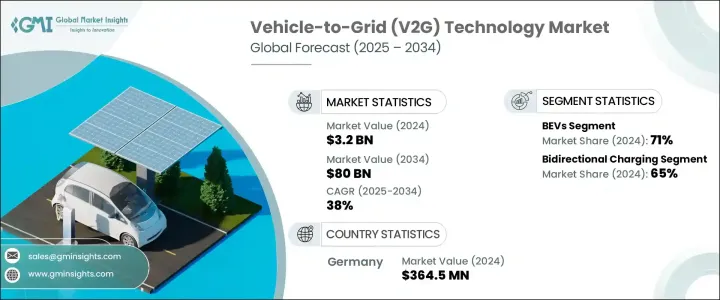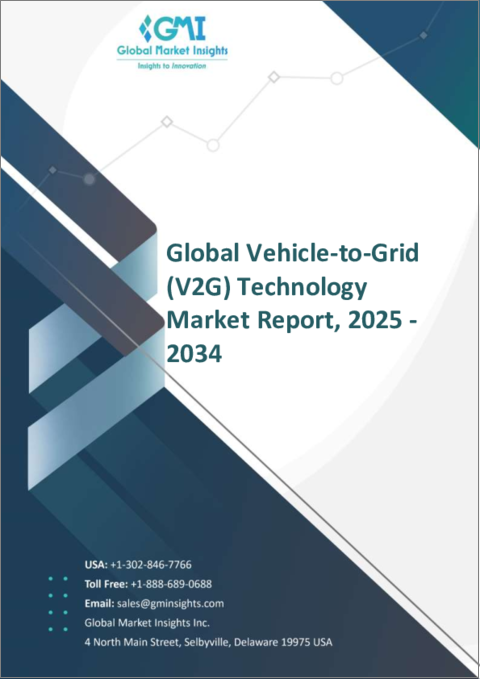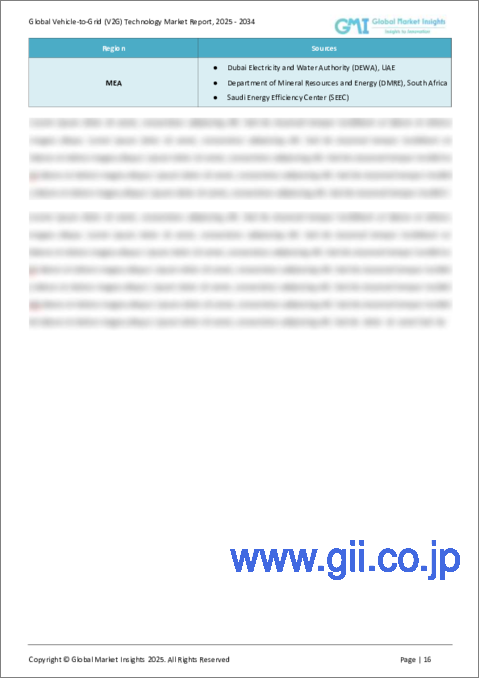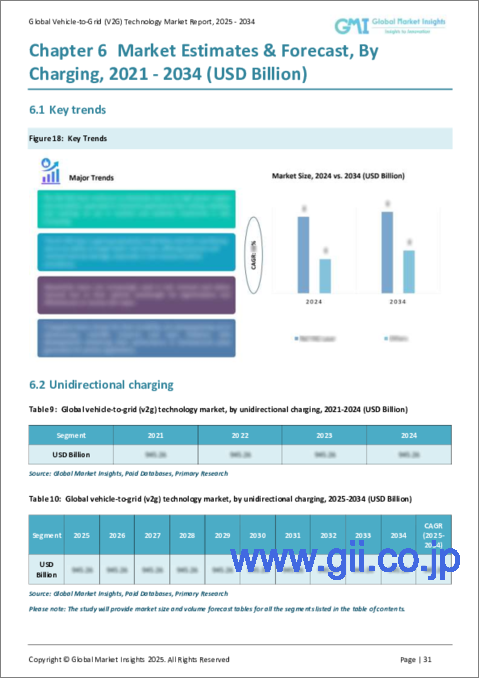|
|
市場調査レポート
商品コード
1740985
V2G(Vehicle to Grid)技術の市場機会、成長促進要因、産業動向分析、予測、2025年~2034年Vehicle-to-Grid (V2G) Technology Market Opportunity, Growth Drivers, Industry Trend Analysis, and Forecast 2025 - 2034 |
||||||
カスタマイズ可能
|
|||||||
| V2G(Vehicle to Grid)技術の市場機会、成長促進要因、産業動向分析、予測、2025年~2034年 |
|
出版日: 2025年04月15日
発行: Global Market Insights Inc.
ページ情報: 英文 170 Pages
納期: 2~3営業日
|
全表示
- 概要
- 目次
世界のV2G(Vehicle to Grid)技術市場は、2024年には32億米ドルと評価され、CAGR 38%で成長し、2034年には800億米ドルに達すると推定されています。
これは、電気自動車の導入が加速していること、スマートグリッドシステムへの投資が増加していること、低炭素インフラを推進する世界の気候目標に後押しされていることによる。世界がよりクリーンなエネルギーソリューションに向かう中、V2G技術は将来のエネルギー展望の重要な柱となりつつあります。電気自動車が主流となり、再生可能エネルギーの統合が急務となる中、V2Gプラットフォームはエネルギーの柔軟性を実現する重要な手段として位置づけられています。

自動車およびエネルギー分野の企業は、ピーク負荷管理をサポートし、電力供給を安定化させ、化石燃料への依存を最小限に抑えるV2Gシステムの商業化に積極的に取り組んでいます。都市化の進展、政府のインセンティブ、技術革新、エネルギー貯蔵ソリューションへのニーズの高まりは、V2Gネットワーク拡大のための肥沃な環境を作り出しています。分散型エネルギーシステムへの動向は、現代のエネルギー・エコシステムにおけるV2Gの役割をさらに増大させ、EV所有者、電力会社、テクノロジープロバイダーのいずれにとっても新たな収益源を生み出しています。各国が輸送排出量削減への取り組みを強化する中、V2Gは、各国のエネルギー課題を世界の気候変動目標に合致させるための重要な戦略と見なされています。
| 市場範囲 | |
|---|---|
| 開始年 | 2024 |
| 予測年 | 2025-2034 |
| 開始金額 | 32億米ドル |
| 予測金額 | 800億米ドル |
| CAGR | 38% |
各国政府は、双方向の充電ネットワークをサポートすることで、国家戦略を国際的な気候変動目標と整合させ、EVがエネルギー消費者としてもエネルギー供給者としてもグリッドと相互作用できるようにしています。電力会社はEVをグリッド資産として活用し、再生可能エネルギーの変動を管理し、ピーク需要の圧力を緩和します。V2G対応のEVフリートは、都市部や工業地帯で、電力需要の高い時間帯に従来の電源の代わりに使用されることが増えています。これらの車両は、蓄電された電力を放電することでグリッド回復力に貢献し、化石燃料発電への依存を最小限に抑えます。テクノロジープロバイダーは、エネルギー使用量の予測、リアルタイムのグリッド通信、エネルギー取引機能などの高度な機能を備えたプラットフォームを構築し、価値創造を後押ししています。いくつかの地域では、政府の資金援助、インセンティブ、インフラ整備により、標準的なEV充電システムのV2G対応への転換が加速しています。
バッテリー電気自動車(BEV)は、2024年の車種別市場シェアで約71%を占め、CAGR38.3%で首位を維持すると予測されています。双方向のエネルギーフローをサポートし、ゼロエミッション運転が可能なBEVは、V2Gシステムとの親和性が高いです。BEVは、公共交通機関やラストワンマイルデリバリーなど、商業車両や都市モビリティプログラムに広く組み込まれています。その利用可能性の拡大は、支援政策と相まって、V2Gエコシステムにおける存在感を高めています。
V2G技術市場における双方向充電分野は、2024年には65%のシェアを占め、2034年までのCAGRは37.7%で成長すると予想されています。これらの充電器は、エネルギーの双方向の移動を可能にし、EVがグリッドから充電するだけでなく、必要に応じて電力を戻すことを可能にします。電力会社や車両運行会社は、余剰の再生可能エネルギーを貯蔵し、需要ピーク時に放出することで、送電網の効率を最適化し、エネルギーコストを削減することができるため、これらのシステムを優先しています。
ドイツのV2G技術市場は、2024年に39%のシェアを占め、3億6,450万米ドルを創出しました。ドイツのリーダーシップは、自動車製造における深い専門知識、広範なEV導入プログラム、双方向のエネルギーフローをサポートできる整備された電力網に起因します。エネルギー転換と電化を支援するドイツの連邦政府のイニシアティブと、送電網近代化への多額の投資が、V2Gインフラのスケールアップを加速させています。
世界の主要自動車メーカーとエネルギー企業は、都市中心部、工業地帯、フリートハブでV2Gプラットフォームを積極的に試験・導入しています。世界のV2G技術市場の主要企業には、ABB, Mitsubishi Motors, NRG Energy, Denso, Hitachi, AC Propulsion, Nissan Motor, Nuvve, Honda Motor, OVO Energyなどがあります。大手V2G企業は、より効率的でスケーラブルな双方向充電技術を開発するため、RandDに多額の投資を行っています。自動車メーカーや電力会社とパートナーシップを結び、パイロットプロジェクトや大規模展開を加速させています。多くの企業は、グリッドの最適化、AIを活用した負荷管理、エネルギー市場の統合など、ソフトウェアの進歩に注力し、収益の最大化を図っています。
目次
第1章 調査手法と範囲
第2章 エグゼクティブサマリー
第3章 業界考察
- エコシステム分析
- サプライヤーの情勢
- 充電インフラプロバイダー
- グリッドオペレーター
- V2Gサービスプロバイダー
- テクノロジープロバイダー
- 最終用途
- トランプ政権による関税への影響
- 貿易への影響
- 貿易量の混乱
- 報復措置
- 業界への影響
- 供給側の影響(原材料)
- 主要原材料の価格変動
- サプライチェーンの再構築
- 生産コストへの影響
- 需要側の影響(顧客へのコスト)
- 最終市場への価格伝達
- 市場シェアの動向
- 消費者の反応パターン
- 供給側の影響(原材料)
- 影響を受ける主要企業
- 戦略的な業界対応
- サプライチェーンの再構成
- 価格設定と製品戦略
- 政策関与
- 展望と今後の検討事項
- 貿易への影響
- 利益率分析
- テクノロジーとイノベーションの情勢
- 特許分析
- 主なニュースと取り組み
- 規制情勢
- 影響要因
- 促進要因
- V2G導入を支援する政府規制と財政的インセンティブ
- 世界中で電気自動車の普及が進む
- 都市化と工業化の進展
- V2G技術の継続的な技術進歩
- 業界の潜在的リスク&課題
- 既存の充電インフラのアップグレードに伴う高コスト
- 標準化された充電インフラの欠如
- 促進要因
- 成長可能性分析
- ポーター分析
- PESTEL分析
第4章 競合情勢
- イントロダクション
- 企業の市場シェア分析
- 競合ポジショニングマトリックス
- 戦略的展望マトリックス
第5章 市場推定・予測:車両別、2021年~2034年
- 主要動向
- EV
- PHEV
- FCV
第6章 市場推定・予測:充電別、2021年~2034年
- 主要動向
- 一方向充電
- 双方向充電
第7章 市場推定・予測:コンポーネント別、2021年~2034年
- 主要動向
- スマートメーター
- EVSE
- ホームエネルギー管理
- ソフトウェアソリューション
第8章 市場推定・予測:用途別、2021年~2034年
- 主要動向
- 国内
- 商業
第9章 市場推定・予測:地域別、2021年~2034年
- 主要動向
- 北米
- 米国
- カナダ
- 欧州
- 英国
- ドイツ
- フランス
- イタリア
- スペイン
- ロシア
- 北欧諸国
- アジア太平洋地域
- 中国
- インド
- 日本
- 韓国
- オーストラリア・ニュージーランド
- 東南アジア
- ラテンアメリカ
- ブラジル
- メキシコ
- アルゼンチン
- 中東・アフリカ
- アラブ首長国連邦
- サウジアラビア
- 南アフリカ
第10章 企業プロファイル
- ABB
- AC Propulsion
- Boulder Electric Vehicle
- Denso Corporation
- Edison International
- EnerDel
- Engie Group
- Fermata Energy
- Groupe Renault
- Hitachi
- Honda Motor
- Indra
- Mitsubishi Motors Corporation
- Nissan Motor Corporation
- NRG Energy
- Nuvve Corporation
- OVO Energy
- PG&E Corporation
- Toyota Shokki
- Wallbox
The Global Vehicle-To-Grid Technology Market was valued at USD 3.2 billion in 2024 and is estimated to grow at a CAGR of 38% to reach USD 80 billion by 2034, driven by the accelerating adoption of electric vehicles, rising investment in smart grid systems, and global climate goals pushing for low-carbon infrastructure. As the world moves toward cleaner energy solutions, V2G technologies are becoming a key pillar of the future energy landscape. With electric vehicles becoming mainstream and renewable energy integration gaining urgency, V2G platforms are positioned as critical enablers of energy flexibility.

Companies across the automotive and energy sectors are working aggressively to commercialize V2G systems that can support peak load management, stabilize power supplies, and minimize dependence on fossil fuels. Growing urbanization, government incentives, technological innovations, and the increasing need for energy storage solutions are creating a fertile environment for the expansion of V2G networks. The trend toward decentralized energy systems is further amplifying the role of V2G in modern energy ecosystems, creating new revenue streams for EV owners, utilities, and technology providers alike. As countries intensify efforts to cut transportation emissions, V2G is seen as a key strategy for aligning national energy agendas with global climate targets.
| Market Scope | |
|---|---|
| Start Year | 2024 |
| Forecast Year | 2025-2034 |
| Start Value | $3.2 Billion |
| Forecast Value | $80 Billion |
| CAGR | 38% |
Governments are aligning national strategies with international climate goals by supporting bidirectional charging networks, allowing EVs to interact with the grid as both energy consumers and energy providers. Utilities leverage EVs as grid assets to manage renewable energy variability and ease peak demand pressures. V2G-enabled EV fleets are increasingly used in cities and industrial areas to replace conventional power sources during high-demand periods. These vehicles contribute to grid resilience by discharging stored electricity, which minimizes reliance on fossil-fueled generation. Technology providers are building platforms with advanced features like predictive energy usage, real-time grid communication, and energy trading capabilities to boost value creation. In several regions, government funding, incentives, and infrastructure upgrades are accelerating the conversion of standard EV charging systems into V2G-capable ones.
Battery electric vehicles (BEVs) dominated the market by vehicle type in 2024, capturing about 71% share, and are forecasted to maintain their lead with a CAGR of 38.3%. Their ability to support bidirectional energy flows and zero-emission operation makes them highly compatible with V2G systems. BEVs are widely integrated into commercial fleets and urban mobility programs, including public transportation and last-mile delivery. Their expanding availability, coupled with supportive policies, is boosting their presence in the V2G ecosystem.
The bidirectional charging segment in the vehicle-to-grid (V2G) technology market held a 65% share in 2024 and is expected to grow at a CAGR of 37.7% through 2034. These chargers allow energy to move in both directions, enabling EVs to not only charge from the grid but also return power when needed. Utilities and fleet operators prioritize these systems for their ability to store surplus renewable energy and release it during demand peaks, optimizing grid efficiency and reducing energy costs.
The Germany Vehicle-To-Grid (V2G) Technology Market held a 39% share in 2024, generating USD 364.5 million. The country's leadership stems from its deep-rooted expertise in automotive manufacturing, extensive EV deployment programs, and a well-developed electric grid capable of supporting bidirectional energy flow. Germany's federal initiatives supporting energy transition and electrification, combined with significant investments in grid modernization, are accelerating the scale-up of V2G infrastructure.
Major automakers and energy companies worldwide are actively testing and implementing V2G platforms in urban centers, industrial zones, and fleet hubs. Key players in the Global Vehicle-To-Grid (V2G) Technology Market include ABB, Mitsubishi Motors, NRG Energy, Denso, Hitachi, AC Propulsion, Nissan Motor, Nuvve, Honda Motor, and OVO Energy. To strengthen their footprint, major V2G players are investing heavily in RandD to develop more efficient and scalable bidirectional charging technologies. They are forming partnerships with automotive manufacturers and utility companies to accelerate pilot projects and large-scale deployments. Many firms focus on software advancements, including grid optimization, AI-driven load management, and energy market integration to maximize returns.
Table of Contents
Chapter 1 Methodology & Scope
- 1.1 Research design
- 1.1.1 Research approach
- 1.1.2 Data collection methods
- 1.2 Base estimates and calculations
- 1.2.1 Base year calculation
- 1.2.2 Key trends for market estimates
- 1.3 Forecast model
- 1.4 Primary research & validation
- 1.4.1 Primary sources
- 1.4.2 Data mining sources
- 1.5 Market definitions
Chapter 2 Executive Summary
- 2.1 Industry 360-degree synopsis, 2021 - 2034
Chapter 3 Industry Insights
- 3.1 Industry ecosystem analysis
- 3.2 Supplier landscape
- 3.2.1 Charging infrastructure providers
- 3.2.2 Grid operators
- 3.2.3 V2G service providers
- 3.2.4 Technology providers
- 3.2.5 End use
- 3.3 Impact of Trump administration tariffs
- 3.3.1 Trade impact
- 3.3.1.1 Trade volume disruptions
- 3.3.1.2 Retaliatory measures
- 3.3.2 Impact on industry
- 3.3.2.1 Supply-side impact (raw materials)
- 3.3.2.1.1 Price volatility in key materials
- 3.3.2.1.2 Supply chain restructuring
- 3.3.2.1.3 Production cost implications
- 3.3.2.2 Demand-side impact (Cost to customers)
- 3.3.2.2.1 Price transmission to end markets
- 3.3.2.2.2 Market share dynamics
- 3.3.2.2.3 Consumer response patterns
- 3.3.2.1 Supply-side impact (raw materials)
- 3.3.3 Key companies impacted
- 3.3.4 Strategic industry responses
- 3.3.4.1 Supply chain reconfiguration
- 3.3.4.2 Pricing and product strategies
- 3.3.4.3 Policy engagement
- 3.3.5 Outlook & future considerations
- 3.3.1 Trade impact
- 3.4 Profit margin analysis
- 3.5 Technology & innovation landscape
- 3.6 Patent analysis
- 3.7 Key news & initiatives
- 3.8 Regulatory landscape
- 3.9 Impact forces
- 3.9.1 Growth drivers
- 3.9.1.1 Supportive government regulations and financial incentives for V2G deployment
- 3.9.1.2 Growing adoption of electric vehicles across the globe
- 3.9.1.3 Rising urbanization and industrialization
- 3.9.1.4 Ongoing technological advancements in V2G technology
- 3.9.2 Industry pitfalls & challenges
- 3.9.2.1 High cost associated with upgrading existing charging infrastructure
- 3.9.2.2 Lack of standardized charging infrastructure
- 3.9.1 Growth drivers
- 3.10 Growth potential analysis
- 3.11 Porter's analysis
- 3.12 PESTEL analysis
Chapter 4 Competitive Landscape, 2024
- 4.1 Introduction
- 4.2 Company market share analysis
- 4.3 Competitive positioning matrix
- 4.4 Strategic outlook matrix
Chapter 5 Market Estimates & Forecast, By Vehicle, 2021 - 2034 ($Bn)
- 5.1 Key trends
- 5.2 BEVs
- 5.3 PHEVs
- 5.4 FCVs
Chapter 6 Market Estimates & Forecast, By Charging, 2021 - 2034 ($Bn)
- 6.1 Key trends
- 6.2 Unidirectional charging
- 6.3 Bidirectional charging
Chapter 7 Market Estimates & Forecast, By Component, 2021 - 2034 ($Bn)
- 7.1 Key trends
- 7.2 Smart meters
- 7.3 Electric vehicle supply equipment (EVSE)
- 7.4 Home energy management
- 7.5 Software solutions
Chapter 8 Market Estimates & Forecast, By Application, 2021 - 2034 ($Bn)
- 8.1 Key trends
- 8.2 Domestic
- 8.3 Commercial
Chapter 9 Market Estimates & Forecast, By Region, 2021 - 2034 ($Bn)
- 9.1 Key trends
- 9.2 North America
- 9.2.1 U.S.
- 9.2.2 Canada
- 9.3 Europe
- 9.3.1 UK
- 9.3.2 Germany
- 9.3.3 France
- 9.3.4 Italy
- 9.3.5 Spain
- 9.3.6 Russia
- 9.3.7 Nordics
- 9.4 Asia Pacific
- 9.4.1 China
- 9.4.2 India
- 9.4.3 Japan
- 9.4.4 South Korea
- 9.4.5 ANZ
- 9.4.6 Southeast Asia
- 9.5 Latin America
- 9.5.1 Brazil
- 9.5.2 Mexico
- 9.5.3 Argentina
- 9.6 MEA
- 9.6.1 UAE
- 9.6.2 Saudi Arabia
- 9.6.3 South Africa
Chapter 10 Company Profiles
- 10.1 ABB
- 10.2 AC Propulsion
- 10.3 Boulder Electric Vehicle
- 10.4 Denso Corporation
- 10.5 Edison International
- 10.6 EnerDel
- 10.7 Engie Group
- 10.8 Fermata Energy
- 10.9 Groupe Renault
- 10.10 Hitachi
- 10.11 Honda Motor
- 10.12 Indra
- 10.13 Mitsubishi Motors Corporation
- 10.14 Nissan Motor Corporation
- 10.15 NRG Energy
- 10.16 Nuvve Corporation
- 10.17 OVO Energy
- 10.18 PG&E Corporation
- 10.19 Toyota Shokki
- 10.20 Wallbox





